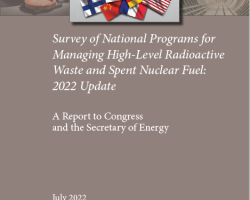Category of Content
Siting Experience Documents Only
Publication Date
Subject Matter
Summary Results for Brine Migration Modeling Performed by LANL, LBNL, and SNL for the UFD Program
Summary Results for Brine Migration Modeling Performed by LANL, LBNL, and SNL for the UFD Program
Modeling Coupled THM Processes and Brine Migration in Salt at High Temperatures
Modeling Coupled THM Processes and Brine Migration in Salt at High Temperatures
Report on Modeling Coupled Processes in the Near Field of a Clay Repository
Report on Modeling Coupled Processes in the Near Field of a Clay Repository
Fluid Flow Modeling in Representative Media
Fluid Flow Modeling in Representative Media
Radionuclide Interaction and Transport in Representative Geologic Media
Radionuclide Interaction and Transport in Representative Geologic Media
Modeling Fluid Flow in Natural Systems: Model Validation and Demonstration
Modeling Fluid Flow in Natural Systems: Model Validation and Demonstration
Brine Migration Experimental Studies for Salt Repositories
Brine Migration Experimental Studies for Salt Repositories
Fluid Flow Model Development for Representative Geologic Media
Fluid Flow Model Development for Representative Geologic Media
FY21 Status Report- SNF Canister Coatings for Corrosion Prevention and Mitigation
FY21 Status Report- SNF Canister Coatings for Corrosion Prevention and Mitigation
Brine Migration Experimental Studies for Salt Repositories
Brine Migration Experimental Studies for Salt Repositories
Interim Storage, Environmental Justice, and Generational Equity
Interim Storage, Environmental Justice, and Generational Equity
With the termination of the Yucca Mountain project, which was proposed to be our nation’s first repository for the disposal of military and civilian spent nuclear fuel and high-level radioactive waste, the future of nuclear waste management and disposal in this country became increasingly uncertain. Interim storage has been advocated by many as a temporary solution while a permanent solution is studied for potentially several more decades to come.
Reset of America's Nuclear Waste Management Strategy and Policy
Reset of America's Nuclear Waste Management Strategy and Policy
The U.S. nuclear waste management program has labored for decades at a cost of billions of dollars each year, and yet there is still no active disposal program either for spent nuclear fuel from commercial reactors or for the high-level radioactive legacy waste and spent nuclear fuel from defense programs.
Interim Storage, Environmental Justice, and Generational Equity
Interim Storage, Environmental Justice, and Generational Equity
With the termination of the Yucca Mountain project, which was proposed to be our nation’s first repository for the disposal of military and civilian spent nuclear fuel and high-level radioactive waste, the future of nuclear waste management and disposal in this country became increasingly uncertain. Interim storage has been advocated by many as a temporary solution while a permanent solution is studied for potentially several more decades to come.
Communicating Risks and Benefits: An Evidence-Based User's Guide
Communicating Risks and Benefits: An Evidence-Based User's Guide
Effective risk communication is essential to the well-being of any organization and those people who depend on it. Ineffective communication can cost lives, money, and reputations. Communicating Risks and Benefits: An Evidence-Based User's Guide provides the scientific foundations for effective communication.
Survey of National Programs for Managing High-Level Radioactive Waste and Spent Nuclear Fuel: 2022 Update
Survey of National Programs for Managing High-Level Radioactive Waste and Spent Nuclear Fuel: 2022 Update
In October 2009, the U.S. Nuclear Waste Technical Review Board (Board or NWTRB) published Survey of National Programs for Managing High-Level Radioactive Waste and Spent Nuclear Fuel. For each of the 13 national programs studied, the report catalogued 15 institutional arrangements that had been set in place and 15 technical approaches that had been taken to design repository systems for the long-term management of high-activity radioactive waste.

